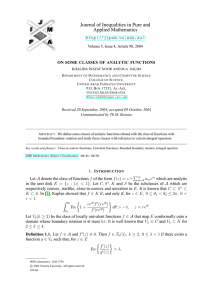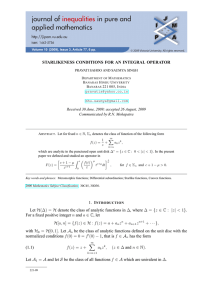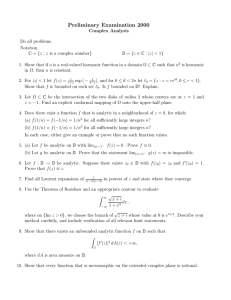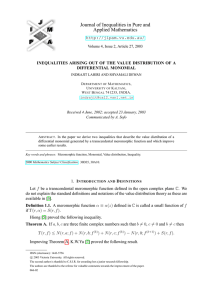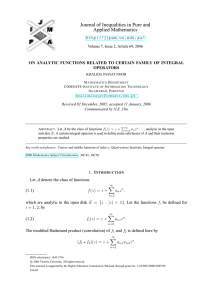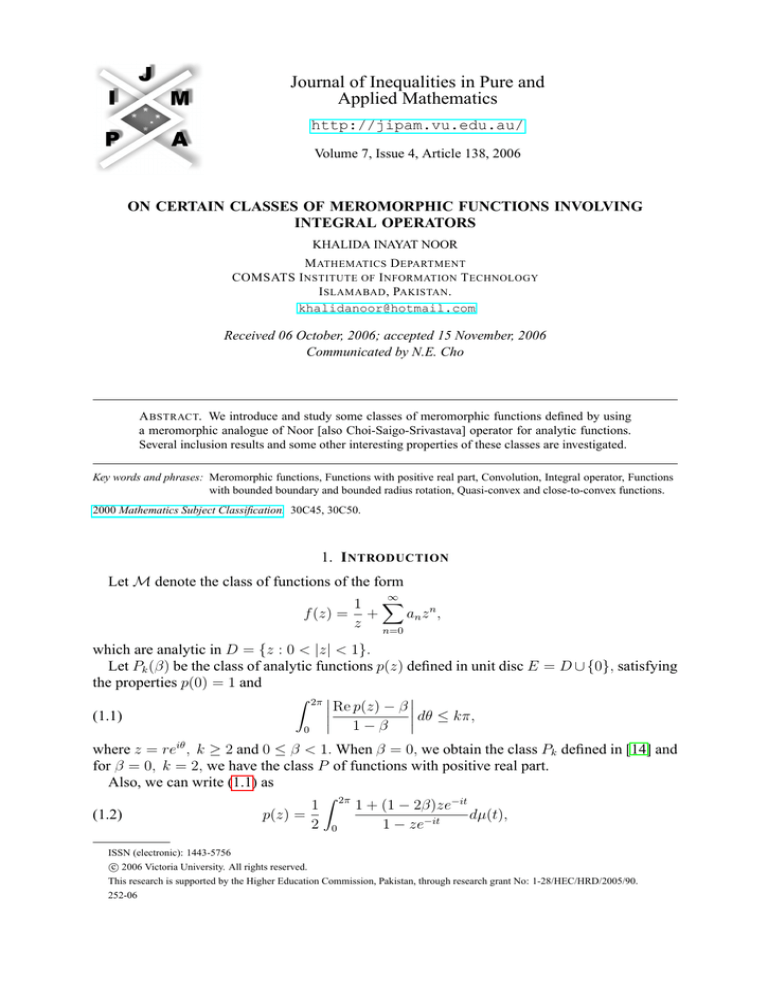
Journal of Inequalities in Pure and
Applied Mathematics
http://jipam.vu.edu.au/
Volume 7, Issue 4, Article 138, 2006
ON CERTAIN CLASSES OF MEROMORPHIC FUNCTIONS INVOLVING
INTEGRAL OPERATORS
KHALIDA INAYAT NOOR
M ATHEMATICS D EPARTMENT
COMSATS I NSTITUTE OF I NFORMATION T ECHNOLOGY
I SLAMABAD , PAKISTAN .
khalidanoor@hotmail.com
Received 06 October, 2006; accepted 15 November, 2006
Communicated by N.E. Cho
A BSTRACT. We introduce and study some classes of meromorphic functions defined by using
a meromorphic analogue of Noor [also Choi-Saigo-Srivastava] operator for analytic functions.
Several inclusion results and some other interesting properties of these classes are investigated.
Key words and phrases: Meromorphic functions, Functions with positive real part, Convolution, Integral operator, Functions
with bounded boundary and bounded radius rotation, Quasi-convex and close-to-convex functions.
2000 Mathematics Subject Classification. 30C45, 30C50.
1. I NTRODUCTION
Let M denote the class of functions of the form
∞
1 X
f (z) = +
an z n ,
z n=0
which are analytic in D = {z : 0 < |z| < 1}.
Let Pk (β) be the class of analytic functions p(z) defined in unit disc E = D ∪ {0}, satisfying
the properties p(0) = 1 and
Z 2π Re p(z) − β (1.1)
1 − β dθ ≤ kπ,
0
where z = reiθ , k ≥ 2 and 0 ≤ β < 1. When β = 0, we obtain the class Pk defined in [14] and
for β = 0, k = 2, we have the class P of functions with positive real part.
Also, we can write (1.1) as
Z
1 2π 1 + (1 − 2β)ze−it
(1.2)
p(z) =
dµ(t),
2 0
1 − ze−it
ISSN (electronic): 1443-5756
c 2006 Victoria University. All rights reserved.
This research is supported by the Higher Education Commission, Pakistan, through research grant No: 1-28/HEC/HRD/2005/90.
252-06
2
K HALIDA I NAYAT N OOR
where µ(t) is a function with bounded variation on [0, 2π] such that
Z 2π
Z 2π
(1.3)
dµ(t) = 2, and
|dµ(t)| ≤ k.
0
0
From (1.1), we can write, for p ∈ Pk (β),
k 1
k 1
(1.4)
p(z) =
+
p1 (z) −
−
p2 (z),
4 2
4 2
where p1 , p2 ∈ P2 (β) = P (β), z ∈ E.
We define the function λ(a, b, z) by
∞
λ(a, b, z) =
1 X (a)n+1 n
+
z ,
z n=0 (c)n+1
z ∈ D,
c 6= 0, −1, −2, . . . , a > 0, where (a)n is the Pochhamer symbol (or the shifted factorial) defined
by
(a)0 = 1, (a)n = a(a + 1) · · · (a + n − 1), n > 1.
We note that
1
2 F1 (1, a; c, z),
z
2 F1 (1, a; c, z) is Gauss hypergeometric function.
Let f ∈ M. Denote by L̃(a, c); M −→ M, the operator defined by
λ(a, c, z) =
z ∈ D,
L̃(a, c)f (z) = λ(a, c, z) ? f (z),
where the symbol ? stands for the Hadamard product (or convolution). The operator L̃(a, c) was
introduced and studied in [5]. This operator is closely related to the Carlson-Shaeffer operator
[1] defined for the space of analytic and univalent functions in E, see [11, 13].
We now introduce a function (λ(a, c, z))(−1) given by
λ(a, c, z) ? (λ(a, c, z))(−1) =
1
,
z(1 − z)µ
(µ > 0),
z ∈ D.
Analogous to L̃(a, c), a linear operator Iµ (a, c) on M is defined as follows, see [2].
(1.5) Iµ (a, c)f (z) = (λ(a, c, z))(−1) ?f (z),
(µ > 0, a > 0,
c 6= 0, −1, −2, . . . ,
z ∈ D).
We note that
I2 (2, 1)f (z) = f (z),
and
I2 (1, 1)f (z) = zf 0 (z) + 2f (z).
It can easily be verified that
(1.6)
z (Iµ (a + 1, c)f (z))0 = aIµ (a, c)f (z) − (a + 1)Iµ (a + 1, c)f (z),
(1.7)
z (Iµ (a, c)f (z))0 = µIµ+1 (a, c)f (z) − (µ + 1)Iµ (a, c)f (z).
We note that the operator Iµ (a, c) is motivated essentially by the operators defined and studied
in [2, 11].
Now, using the operator Iµ (a, c), we define the following classes of meromorphic functions
for µ > 0, 0 ≤ η, β < 1, α ≥ 0, z ∈ D.
We shall assume, unless stated otherwise, that a 6= 0, −1, −2, . . . , c 6= 0, −1, −2, . . .
J. Inequal. Pure and Appl. Math., 7(4) Art. 138, 2006
http://jipam.vu.edu.au/
M EROMORPHIC F UNCTIONS I NVOLVING I NTEGRAL O PERATORS
3
Definition 1.1. A function f ∈ M is said to belong to the class M Rk (η) for z ∈ D, 0 ≤ η <
1, k ≥ 2, if and only if
zf 0 (z)
−
∈ Pk (η)
f (z)
and f ∈ M Vk (η), for z ∈ D, 0 ≤ η < 1, k ≥ 2, if and only if
−
(zf 0 (z))0
∈ Pk (η).
f 0 (z)
We call f ∈ M Rk (η), a meromorphic function with bounded radius rotation of order η and
f ∈ M Vk a meromorphic function with bounded boundary rotation.
Definition 1.2. Let f ∈ M, 0 ≤ η < 1, k ≥ 2, z ∈ D. Then
f ∈ M Rk (µ, η, a, c) if and only if
Iµ (a, c)f ∈ M Rk (η).
Also
f ∈ M Vk (µ, η, a, c) if and only if
Iµ (a, c)f ∈ M Vk (η),
z ∈ D.
We note that, for z ∈ D,
f ∈ M Vk (µ, η, a, c)
⇐⇒
−zf 0 ∈ M Rk (µ, η, a, c).
Definition 1.3. Let α ≥ 0, f ∈ M, 0 ≤ η, β < 1, µ > 0 and z ∈ D. Then f ∈ Bkα (µ, β, η, a, c),
if and only if there exists a function g ∈ M C(µ, η, a, c), such that
(z(Iµ (a, c)f (z))0 )0
(Iµ (a, c)f (z))0
(1 − α)
+α −
∈ Pk (β).
(Iµ (a, c)g(z))0
(Iµ (a, c)g(z))0
In particular, for α = 0, k = a = µ = 2, and c = 1, we obtain the class of meromorphic
close-to-convex functions, see [4]. For α = 1, k = µ = a = 2, c = 1, we have the class of
meromorphic quasi-convex functions defined for z ∈ D. We note that the class C ? of quasiconvex univalent functions, analytic in E, were first introduced and studied in [7]. See also
[9, 12].
The following lemma will be required in our investigation.
Lemma 1.1 ([6]). Let u = u1 + iu2 and v = v1 + iv2 and let Φ(u, v) be a complex-valued
function satisfying the conditions:
(i) Φ(u, v) is continuous in a domain D ⊂ C 2 ,
(ii) (1, 0) ∈ D and Φ(1, 0) > 0.
2
(iii) Re Φ(iu2 , v1 ) ≤ 0 whenever (iu2 , v1 ) ∈ D and v1 ≤ − 21 (1 + u2 ).
P
m
If h(z) = 1 + ∞
is a function, analytic in E, such that (h(z), zh0 (z)) ∈ D and
m=1 cm z
0
Re(h(z), zh (z)) > 0 for z ∈ E, then Re h(z) > 0 in E.
2. M AIN R ESULTS
Theorem 2.1.
M Rk (µ + 1, η, a, c) ⊂ M Rk (µ, β, a, c) ⊂ M Rk (µ, γ, a + 1, c).
Proof. We prove the first part of the result and the second part follows by using similar arguments. Let
f ∈ M Rk (µ + 1, η, a, c), z ∈ D
J. Inequal. Pure and Appl. Math., 7(4) Art. 138, 2006
http://jipam.vu.edu.au/
4
K HALIDA I NAYAT N OOR
and set
k 1
k 1
H(z) =
+
h1 (z) −
−
h2 (z)
4 2
4 2
z(Iµ (a, c)f (z))0
=−
,
Iµ (a, c)f (z)
(2.1)
where H(z) is analytic in E with H(0) = 1.
Simple computation together with (2.1) and (1.7) yields
z (Iµ+1 (a, c)f (z))0
zH 0 (z)
(2.2)
−
= H(z) +
∈ Pk (η),
Iµ+1 (a, c)f (z)
−H(z) + µ + 1
z ∈ E.
Let
"
Φµ (z) =
∞
X
#
"
∞
X
#
1
1
µ
1
+
zk +
+
kz k ,
µ + 1 z k=0
µ + 1 z k=0
then
(2.3)
zH 0 (z)
(H(z) ? zΦµ (z)) = H(z) +
−H(z) + µ + 1
k 1
k 1
=
+
(h1 (z) ? zΦµ (z)) −
−
(h2 (z) ? zΦµ (z))
4 2
4 2
k 1
zh01 (z)
=
+
h1 (z) +
4 2
−h1 (z) + µ + 1
k 1
zh02 (z)
−
−
h2 (z) +
.
4 2
−h2 (z) + µ + 1
Since f ∈ M Rk (µ + 1, η, a, c), it follows from (2.2) and (2.3) that
zh0i (z)
∈ P (η), i = 1, 2,
hi (z) +
−hi (z) + µ + 1
z ∈ E.
Let hi (z) = (1 − β)pi (z) + β. Then
(1 − β)zp0i (z)
(1 − β)pi (z) +
+ (β − η) ∈ P,
−(1 − β)pi (z) − β + µ + 1
z ∈ E.
We shall show that pi ∈ P, i = 1, 2.
We form the functional Φ(u, v) by taking u = pi (z), v = zp0i (z) with u = u1 + iu2 , v =
v1 + iv2 . The first two conditions of Lemma 1.1 can easily be verified. We proceed to verify the
condition (iii).
Φ(u, v) = (1 − β)u +
(1 − β)v
+ (β − η),
−(1 − β)u − β + µ + 1
implies that
Re Φ(iu2 , v1 ) = (β − η) +
(1 − β)(1 + µ − β)v1
.
(1 + µ − β)2 + (1 − β)2 u22
By taking v1 ≤ − 21 (1 + u22 ), we have
Re Φ(iu2 , v1 ) ≤
J. Inequal. Pure and Appl. Math., 7(4) Art. 138, 2006
A + Bu22
,
2C
http://jipam.vu.edu.au/
M EROMORPHIC F UNCTIONS I NVOLVING I NTEGRAL O PERATORS
5
where
A = 2(β − η)(1 + µ − β)2 − (1 − β)(1 + µ − β),
B = 2(β − η)(1 − β)2 − (1 − β)(1 + µ − β),
C = (1 + µ − β)2 + (1 − β)2 u22 > 0.
We note that Re Φ(iu2 , v1 ) ≤ 0 if and only if A ≤ 0 and B ≤ 0. From A ≤ 0, we obtain
i
p
1h
2
(2.4)
β=
(3 + 2µ + 2η) − (3 + 2µ + 2η) − 8 ,
4
and B ≤ 0 gives us 0 ≤ β < 1.
Now using Lemma 1.1, we see that pi ∈ P for z ∈ E, i = 1, 2 and hence f ∈ M Rk (µ, β, a, c)
with β given by (2.4).
In particular, we note that
i
p
1h
2
β=
(3 + 2µ) − 4µ + 12µ + 1 .
4
Theorem 2.2.
M Vk (µ + 1, η, a, c) ⊂ M Vk (µ, β, a, , c) ⊂ M Vk (µ, γ, a + 1, c).
Proof.
f ∈ M Vk (µ + 1, η, a, c)
⇐⇒
−zf 0 ∈ M Rk (µ + 1, η, a, c)
⇒ −zf 0 ∈ M Rk (µ, β, a, c)
⇐⇒ f ∈ M Vk (µ, β, a, c),
where β is given by (2.4).
The second part can be proved with similar arguments.
Theorem 2.3.
Bkα (µ + 1, β1 , η1 , a, c) ⊂ Bkα (µ, β2 , η2 , a, c) ⊂ Bkα (µ, β3 , η3 , a + 1, c),
where ηi = ηi (βi , µ), i = 1, 2, 3 are given in the proof.
Proof. We prove the first inclusion of this result and other part follows along similar lines. Let
f ∈ Bkα (µ + 1, β1 , η1 , a, c). Then, by Definition 1.3, there exists a function g ∈ M V2 (µ +
1, η1 , a, c) such that
(Iµ+1 (a, c)f (z))0
(z(Iµ+1 (a, c)f (z))0 )0
(2.5)
(1 − α)
+α −
∈ Pk (β1 ).
(Iµ+1 (a, c)g(z))0
(Iµ+1 (a, c)g(z))0
Set
(Iµ (a, c)f (z))0
(z(Iµ (a, c)f (z))0 )0
p(z) = (1 − α)
+α −
,
(Iµ (a, c)g(z))0
(Iµ (a, c)g(z))0
(2.6)
where p is an analytic function in E with p(0) = 1.
Now, g ∈ M V2 (µ + 1, η1 , a, c) ⊂ M V2 (µ, η2 , a, c), where η2 is given by the equation
(2.7)
2η22 + (3 + 2µ − 2η1 )η2 − [2η1 (1 + µ) + 1] = 0.
Therefore,
q(z) =
(z(Iµ (a, c)g(z))0 )0
−
(Iµ (a, c)g(z))0
J. Inequal. Pure and Appl. Math., 7(4) Art. 138, 2006
∈ P (η2 ),
z ∈ E.
http://jipam.vu.edu.au/
6
K HALIDA I NAYAT N OOR
By using (1.7), (2.5), (2.6) and (2.7), we have
zp0 (z)
(2.8)
p(z) + α
∈ Pk (β1 ), q ∈ P (η2 ), z ∈ E.
−q(z) + µ + 1
With
k 1
k 1
p(z) =
+
[(1 − β2 )p1 (z) + β2 ] −
−
[(1 − β2 )p2 (z) + β2 ] ,
4 2
4 2
(2.8) can be written as
k 1
(1 − β2 )zp01 (z)
+
(1 − β2 )p1 (z) + α
+ β2
4 2
−q(z) + µ + 1
(1 − β2 )zp02 (z)
k 1
−
(1 − β2 )p2 (z) + α
+ β2 ,
−
4 2
−q(z) + µ + 1
where
(1 − β2 )zp0i (z)
(1 − β2 )pi (z) + α
+ β2 ∈ P (β1 ), z ∈ E, i = 1, 2.
−q(z) + µ + 1
That is
(1 − β2 )zp0i (z)
(1 − β2 )pi (z) + α
+ (β2 − β1 ) ∈ P, z ∈ E, i = 1, 2.
−q(z) + µ + 1
We form the functional Ψ(u, v) by taking u = u1 + iu2 = pi , v = v1 + iv2 = zp0i , and
Ψ(u, v) = (1 − β2 )u + α
(1 − β2 )v
+ (β2 − β1 ),
(−q1 + iq2 ) + µ + 1
(q = q1 + iq2 ).
The first two conditions of Lemma 1.1 are clearly satisfied. We verify (iii), with v1 ≤ − 12 (1+u22 )
as follows
α(1 − β2 )v1 {(−q1 + µ + 1) + iq2 }
Re Ψ(iu2 , v1 ) = (β2 − β1 ) + Re
(−q + µ + 1)2 + q22
2(β − 2 − β1 )| − q + µ + 1|2 − α(1 − β2 )(−q1 + µ + 1)(1 + u22 )
≤
2| − q + µ + 1|2
A + Bu22
=
, C = | − q + µ + 1|2 > 0
2C
≤ 0, if A ≤ 0 and B ≤ 0,
where
A = 2(β2 − β1 )| − q + µ + 1|2 − α(1 − β2 )(−q1 + µ + 1),
B = −α(1 − β2 )(−q1 + µ + 1) ≤ 0.
From A ≤ 0, we get
(2.9)
β2 =
2β1 | − q + µ + 1|2 + α Re(−q(z) + µ + 1)
.
2| − q + µ + 1|2 + α Re(−q(z) + µ + 1)
Hence, using Lemma 1.1, it follows that p(z), defined by (2.6), belongs to Pk (β2 ) and thus
f ∈ Bkα (µ, β2 , η2 , a, c), z ∈ D. This completes the proof of the first part. The second part of
this result can be obtained by using similar arguments and the relation (1.6).
Theorem 2.4.
(i)
Bkα (µ, β, η, a, c) ⊂ Bk0 (µ, γ, η, a, c)
(ii)
Bkα1 (µ, β, η, a, c) ⊂ Bkα2 (µ, β, η, a, c),
J. Inequal. Pure and Appl. Math., 7(4) Art. 138, 2006
for
0 ≤ α2 < α1 .
http://jipam.vu.edu.au/
M EROMORPHIC F UNCTIONS I NVOLVING I NTEGRAL O PERATORS
7
Proof. (i). Let
(Iµ (a, c)f (z))0
h(z) =
,
(Iµ (a, c)g(z))0
h(z) is analytic in E and h(0) = 1. Then
(Iµ (a, c)f (z))0
(z(Iµ (a, c)f (z))0 )0
zh0 (z)
(2.10)
(1 − α)
+
α
−
=
h(z)
+
α
,
(Iµ (a, c)g(z))0
(Iµ (a, c)g(z))0
−h0 (z)
where
(z(Iµ (a, c)g(z))0 )0
∈ P (η).
h0 (z) = −
(Iµ (a, c)g(z))0
Since f ∈ Bkα (µ, β, η, a, c), it follows that
zh0 (z)
h(z) + α
∈ Pk (β), h0 ∈ P (η), for z ∈ E.
−h0 (z)
Let
k 1
k 1
h(z) =
+
h1 (z) −
−
h2 (z).
4 2
4 2
Then (2.10) implies that
zh0i (z)
hi (z) + α
∈ P (β), z ∈ E, i = 1, 2,
−h0 (z)
and from use of similar arguments, together with Lemma 1.1, it follows that hi ∈ P (γ), i =
1, 2, where
2β|h0 |2 + α Re h0
γ=
.
2|h0 |2 + α Re h0
Therefore h ∈ Pk (γ), and f ∈ Bk0 (µ, γ, η, a, c), z ∈ D. In particular, it can be shown that
hi ∈ P (β), i = 1, 2. Consequently h ∈ Pk (β) and f ∈ Bk0 (µ, β, η, a, c) in D.
For α2 = 0, we have (i). Therefore, we let α2 > 0 and f ∈ Bkα1 (µ, β, η, a, c). There exist
two functions H1 , H2 ∈ Pk (β) such that
(Iµ (a, c)f (z))0
(z(Iµ (a, c)f (z))0 )0
H1 (z) = (1 − α1 )
+ α1 −
(Iµ (a, c)g(z))0
(Iµ (a, c)g(z))0
(Iµ (a, c)f (z))0
H2 (z) =
, g ∈ M V2 (µ, η, a, c).
(Iµ (a, c)g(z))0
Now
(Iµ (a, c)f (z))0
(z(Iµ (a, c)f (z))0 )0
(2.11)
(1 − α2 )
+ α2 −
(Iµ (a, c)g(z))0
(Iµ (a, c)g(z))0
α2
α2
= H1 (z) + 1 −
H2 (z).
α1
α1
Since the class Pk (β) is a convex set [10], it follows that the right hand side of (2.11) belongs
to Pk (β) and this shows that f ∈ Bkα2 (µ, β, η, a, c) for z ∈ D. This completes the proof.
Let f ∈ M, b > 0 and let the integral operator Fb be defined by
Z z
b
(2.12)
Fb (f ) = Fb (f )(z) = b+1
tb f (t)dt.
z
0
From (2.12), we note that
(2.13)
z (Iµ (a, c)Fb (f )(z))0 = bIµ (a, c)f (z) − (b + 1)Iµ (a, c)Fb (f )(z).
J. Inequal. Pure and Appl. Math., 7(4) Art. 138, 2006
http://jipam.vu.edu.au/
8
K HALIDA I NAYAT N OOR
Using (2.12), (2.13) with similar techniques used earlier, we can prove the following:
Theorem 2.5. Let f ∈ M Rk (µ, β, a, c), or M Vk (µ, β, a, c), or Bkα (µ, β, η, a, c), for z ∈ D.
Then Fb (f ) defined by (2.12) is also in the same class for z ∈ D.
R EFERENCES
[1] B.C. CARLSON AND D.B. SCHAEFFER, Starlike and prestarlike hypergeometric functions, SIAM
J. Math. Anal., 15 (1984), 737–745.
[2] N.E. CHO AND K. INAYAT NOOR, Inclusion properties for certain classes of meromorphic functions associated with Choi-Saigo-Srivastava operator, J. Math. Anal. Appl., 320 (2006), 779–786
[3] J.H. CHOI, M. SAIGO AND H.M. SRIVASTAVA, Some inclusion properties of a certain family of
integral operators, J. Math. Anal. Appl., 276 (2002), 432–445.
[4] V. KUMAR AND S.L. SHULKA, Certain integrals for classes of p-valent meromorphic functions,
Bull. Austral. Math. Soc., 25 (1982), 85–97.
[5] J.L. LIU AND H.M. SRIVASTAVA, A linear operator and associated families of meromorphically
multivalued functions, J. Math. Anal. Appl., 259 (2001), 566–581.
[6] S.S. MILLER, Differential inequalities and Caratheodory functions, Bull. Amer. Math. Soc., 81
(1975), 79–81.
[7] K.I. NOOR, On close-to-conex and related functions, Ph.D Thesis, University of Wales, Swansea,
U. K., 1972.
[8] K.I. NOOR, A subclass of close-to-convex functions of order β type γ, Tamkang J. Math., 18
(1987), 17–33.
[9] K.I. NOOR, On quasi-convex functions and related topics, Inter. J. Math. Math. Sci., 10 (1987),
241–258.
[10] K.I. NOOR, On subclasses of close-to-convex functions of higher order, Inter. J. Math. Math. Sci.,
15 (1992), 279–290.
[11] K.I. NOOR, Classes of analytic functions defined by the Hadamard product, New Zealand J. Math.,
24 (1995), 53–64.
[12] K.I. NOOR AND D.K. THOMAS, On quasi-convex univalent functions, Inter. J. Math. Math. Sci.,
3 (1980), 255–266.
[13] K.I. NOOR AND M.A. NOOR, On integral operators, J. Math. Anal. Appl., 238 (1999), 341–352.
[14] B. PINCHUK, Functions with bounded boundary rotation, Isr. J. Math., 10 (1971), 7–16.
J. Inequal. Pure and Appl. Math., 7(4) Art. 138, 2006
http://jipam.vu.edu.au/

![Mathematics 414 2003–04 Exercises 5 [Due Monday February 16th, 2004.]](http://s2.studylib.net/store/data/010415766_1-b65af2bb66ab8e422354912dcedcb6a6-300x300.png)


